Self-Cleaning Photocatalytic Polyurethane Coatings Containing Modified C60 Fullerene Additives
Abstract
:1. Introduction
2. Experimental Section
2.1. Materials
2.2. Synthesis of EO3–C60
2.3. Polymer Preparation
2.4. Coating Characterization
2.5. Contaminant Challenge
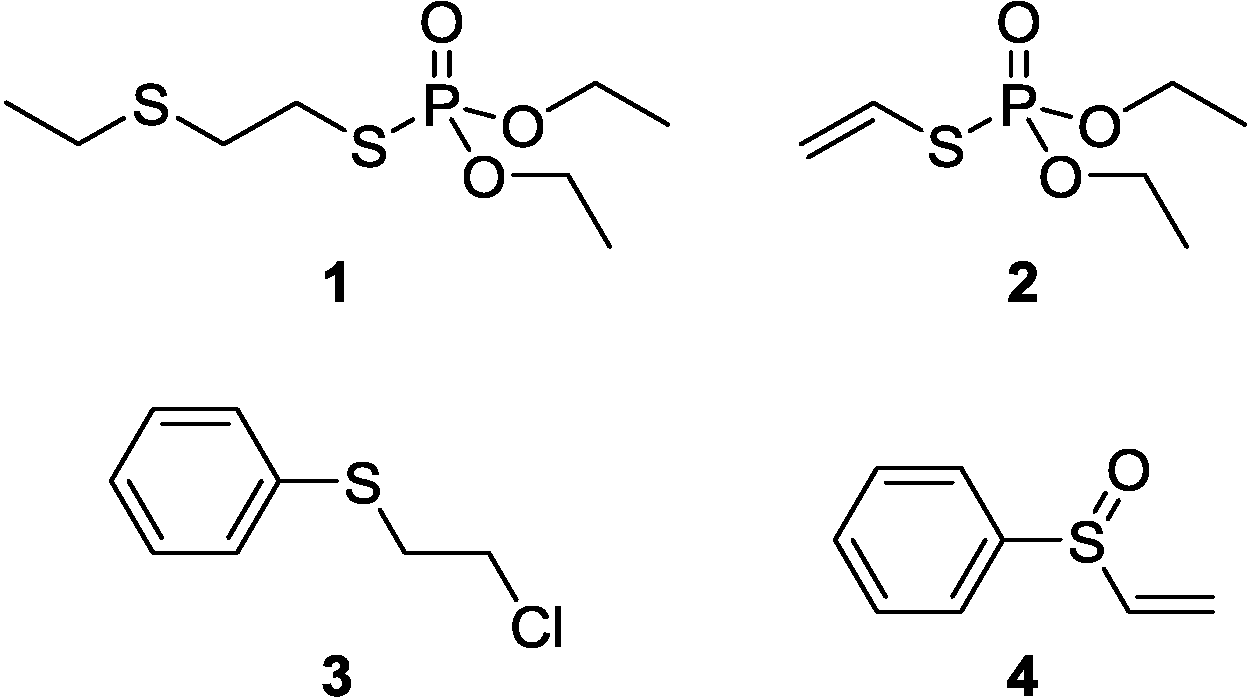
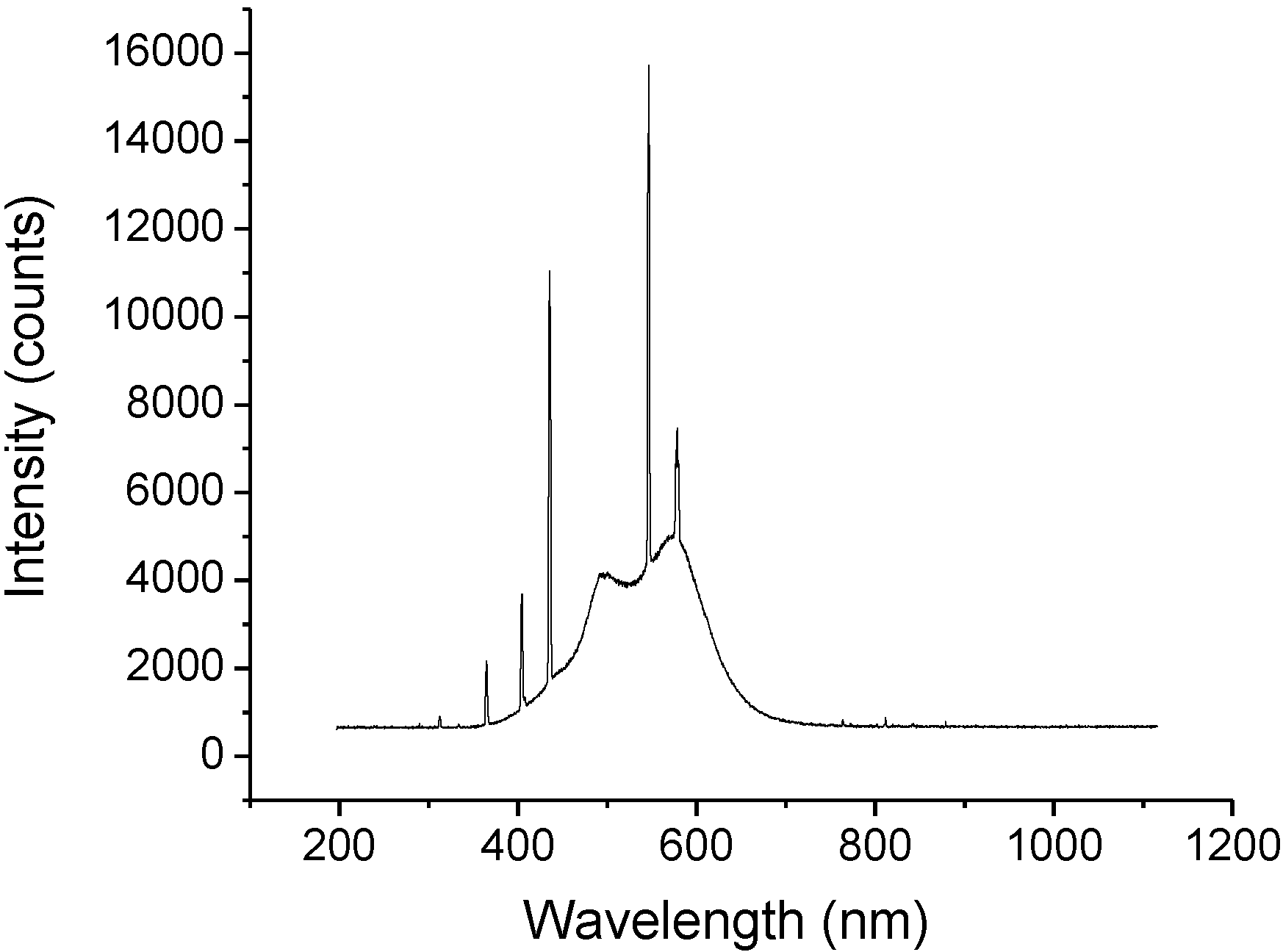
3. Results and Discussion
3.1. Additive–Polymer Compatibility
| Tecoflex Film | 10% Loss (°C) | Mass Remaining (%) * |
|---|---|---|
| Control | 300.55 | 0.2727 |
| 0.5% C60 | 314.99 | 1.463 |
| 1.0% C60 | 311.07 | 2.561 |
| 2.5% C60 | 307.38 | 6.574 |
| 5.0% C60 | 309.86 | 11.25 |
| 0.25% EO3–C60 | 312.61 | 0.6591 |
| 0.5% EO3–C60 | 319.44 | 0.7918 |
| 1.0% EO3–C60 | 325.63 | 1.513 |
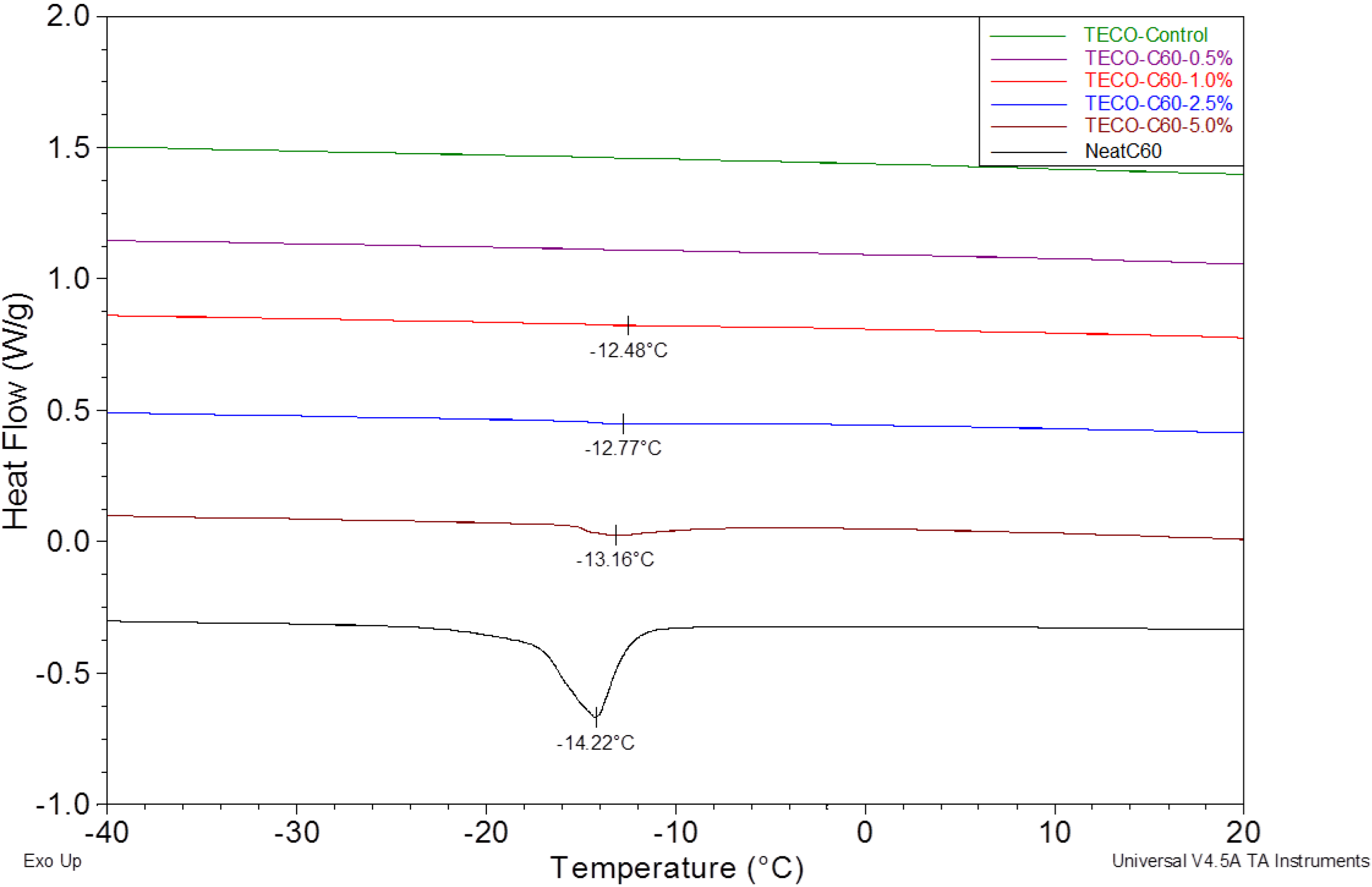
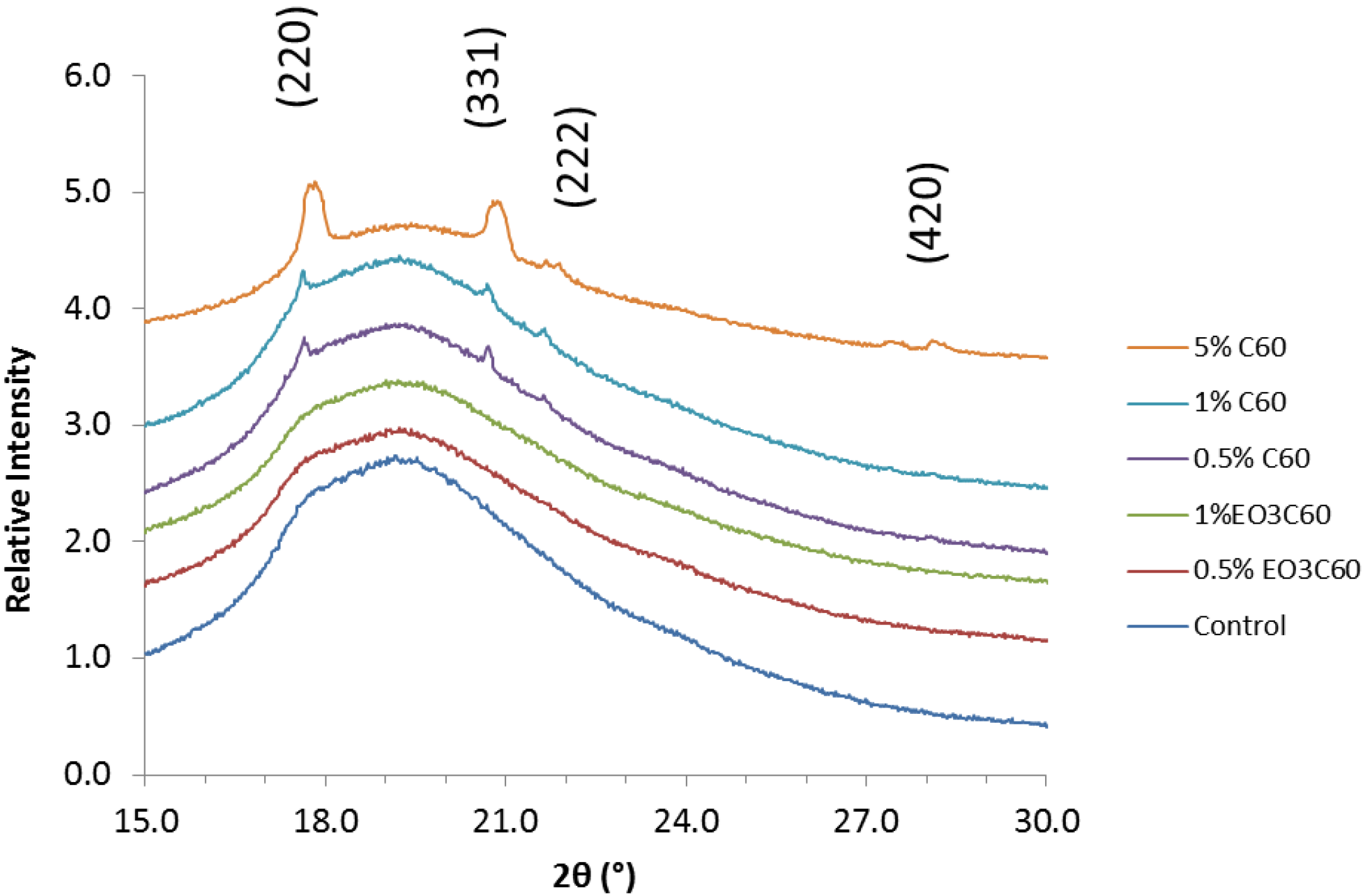
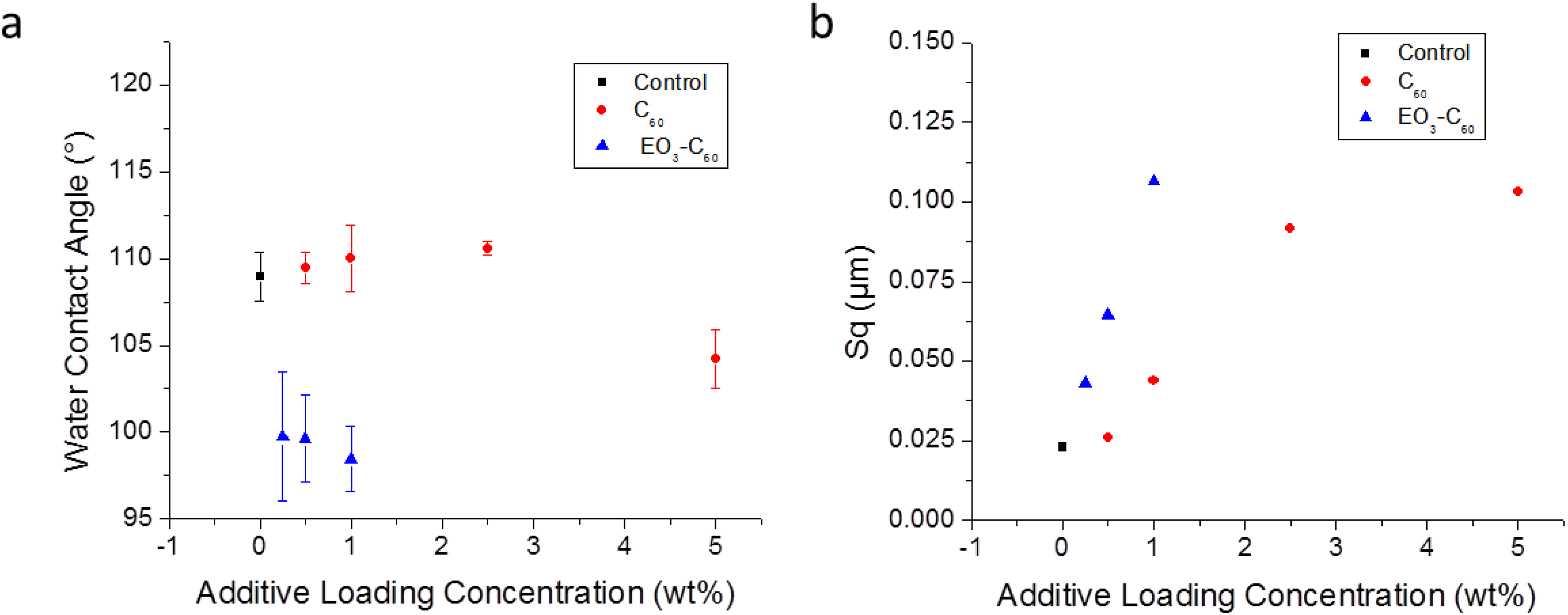
3.2. Decontamination Challenges
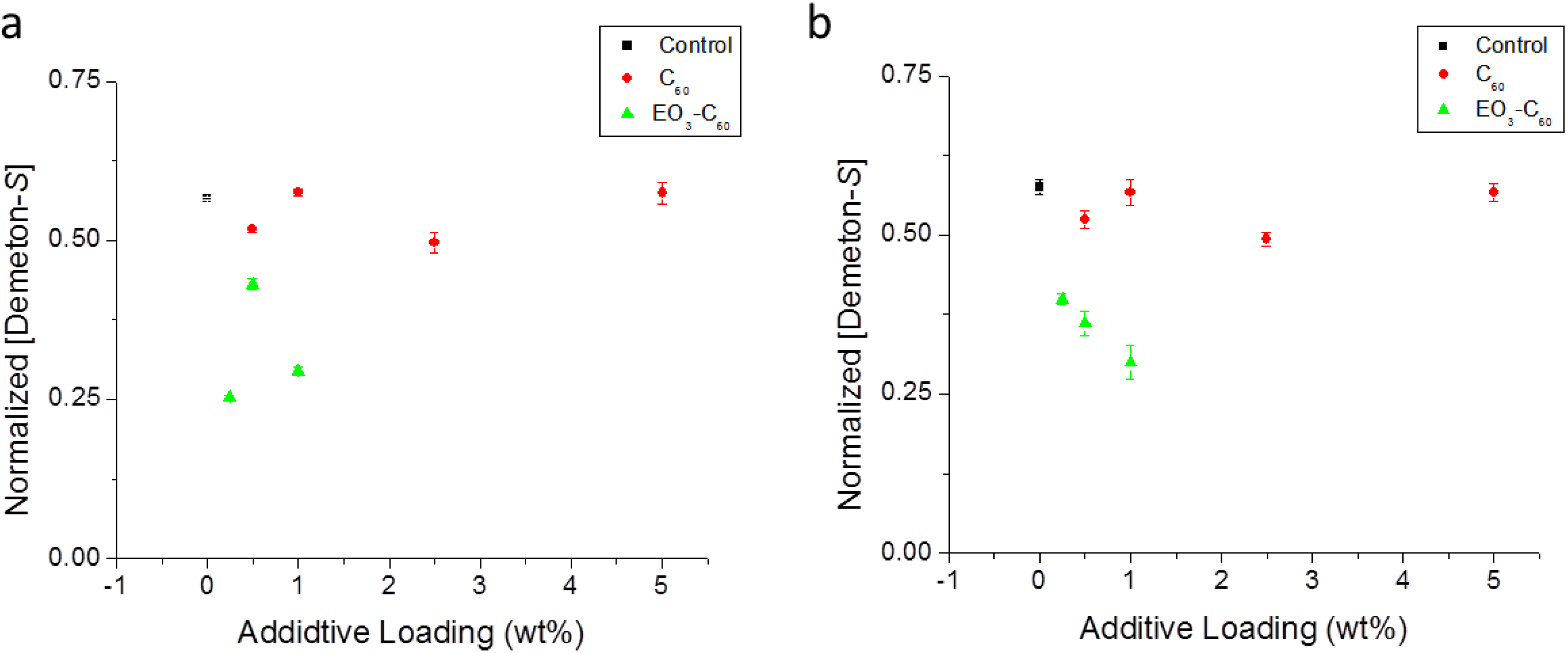
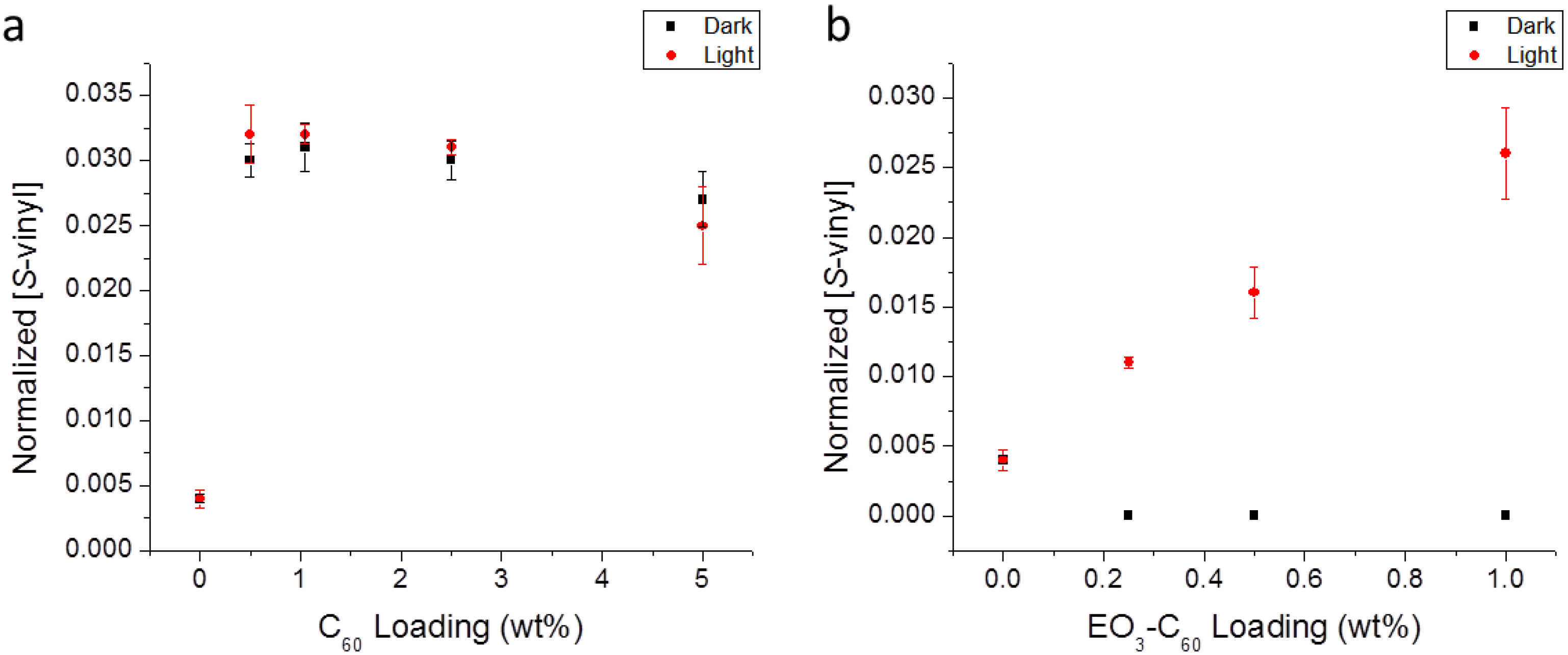


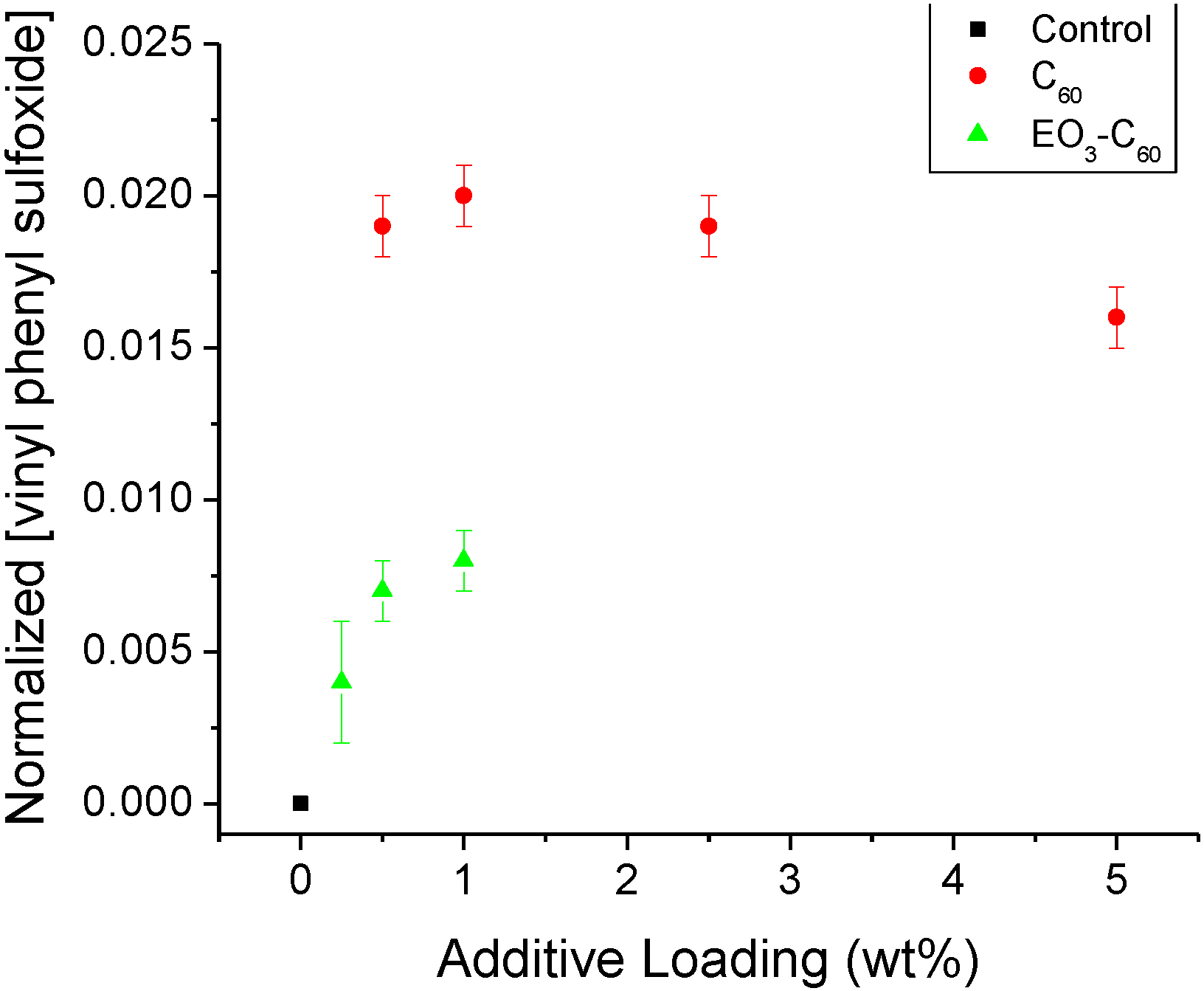
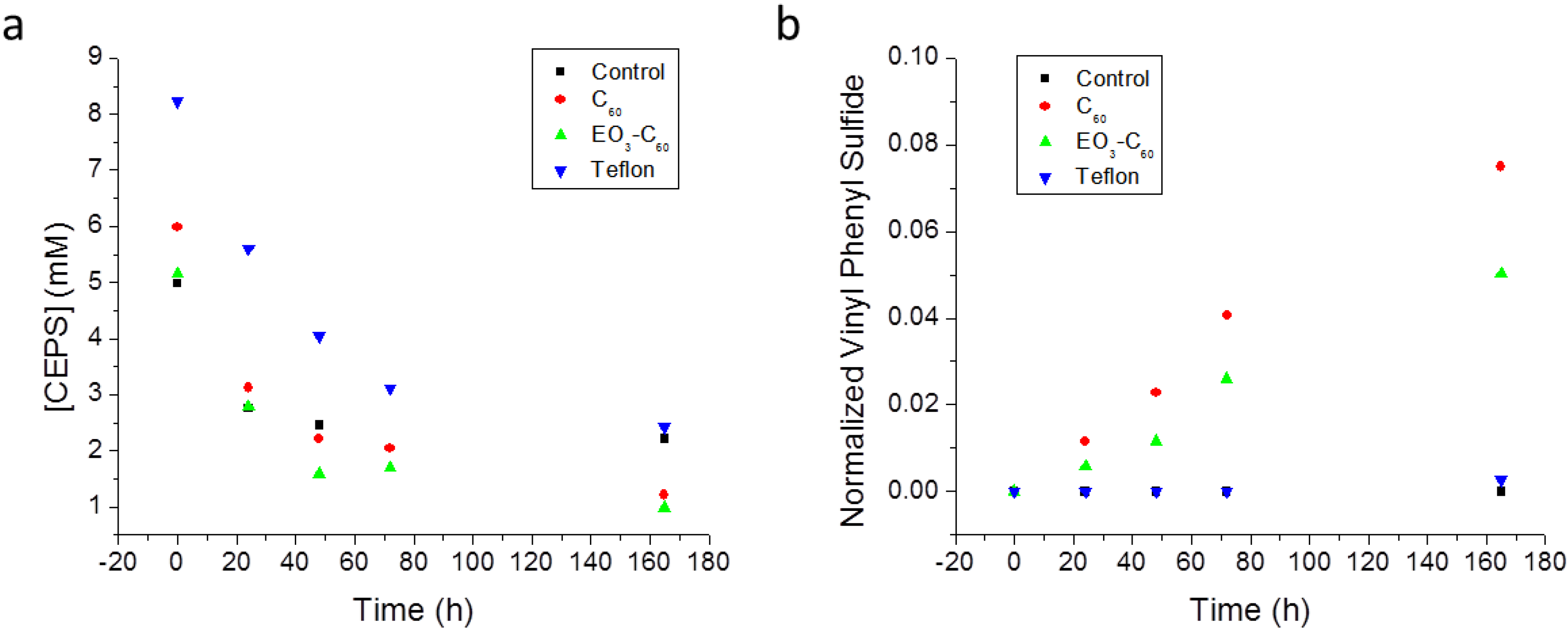

4. Conclusions
Acknowledgments
Author Contributions
Conflicts of Interest
References
- Bartelt-Hunt, S.L.; Knappe, D.R.U.; Barlaz, M.A. A review of chemical warfare agent simulants for the study of environmental behavior. Crit. Rev. Environ. Sci. Technol. 2008, 38, 112–136. [Google Scholar]
- Gephart, R.T.; Coneski, P.N.; Wynne, J.H. Decontamination of chemical-warfare agent simulants by polymer surfaces doped with the singlet oxygen generator zinc octaphenoxyphthalocyanine. ACS Appl. Mater. Interfaces 2013, 5, 10191–10200. [Google Scholar] [CrossRef]
- Chattopadhyay, D.K.; Raju, K.V.S.N. Structural engineering of polyurethane coatings for high performance applications. Prog. Polym. Sci. 2007, 32, 352–418. [Google Scholar] [CrossRef]
- Wynne, J.H.; Pant, R.R.; Jones-Meehan, J.M.; Phillips, J.P. Preparation and evaluation of nonionic amphiphilic phenolic biocides in urethane hydrogels. J. Appl. Polym. Sci. 2008, 107, 2089–2094. [Google Scholar] [CrossRef]
- Pant, R.R.; Buckley, J.L.; Fulmer, P.A.; Wynne, J.H.; McCluskey, D.M.; Phillips, J.P. Hybrid siloxane epoxy coatings containing quaternary ammonium moieties. J. Appl. Polym. Sci. 2008, 110, 3080–3086. [Google Scholar] [CrossRef]
- Kurt, P.; Wood, L.; Ohman, D.E.; Wynne, K.J. Highly effective contact antimicrobial surfaces via polymer surface modifiers. Langmuir 2007, 23, 4719–4723. [Google Scholar]
- Harney, M.B.; Pant, R.R.; Fulmer, P.A.; Wynne, J.H. Surface self-concentrating amphiphilic quaternary ammonium biocides as coating additives. ACS Appl. Mater. Interfaces 2009, 1, 39–41. [Google Scholar] [CrossRef]
- Pant, R.R.; Fulmer, P.A.; Harney, M.B.; Buckley, J.P.; Wynne, J.H. Synthesis and biocidal efficacy of self-spreading polydimethylsiloxane oligomers possessing oxyethylene-functionalized quaternary ammoniums. J. Appl. Polym. Sci. 2009, 113, 2397–2403. [Google Scholar] [CrossRef]
- Pant, R.R.; Rasley, B.T.; Buckley, J.P.; Lloyd, C.T.; Cozzens, R.F.; Santangelo, P.G.; Wynne, J.H. Synthesis, mobility study and antimicrobial evaluation or novel self-spreading ionic silicone oligomers. J. Appl. Polym. Sci. 2007, 104, 2954–2964. [Google Scholar] [CrossRef]
- Fulmer, P.A.; Lundin, J.G.; Wynne, J.H. Development of antimicrobial peptides (amps) for use in self-decontaminating coatings. ACS Appl. Mater. Interfaces 2010, 2, 1266–1270. [Google Scholar]
- Talmage, S.S.; Watson, A.P.; Hauschild, V.; Munro, N.B.; King, J. Chemical warfare agent degradation and decontamination. Curr. Org. Chem. 2007, 11, 285–298. [Google Scholar] [CrossRef]
- Arbogast, J.W.; Darmanyan, A.P.; Foote, C.S.; Diederich, F.N.; Whetten, R.L.; Rubin, Y.; Alvarez, M.M.; Anz, S.J. Photophysical properties of sixty atom carbon molecule (C60). J. Phys. Chem. 1991, 95, 11–12. [Google Scholar]
- Nagano, T.; Arakane, K.; Ryu, A.; Masunaga, T.; Shinmoto, K.; Mashiko, S.; Hirobe, M. Comparison of singlet oxygen production efficiency of C60 with other photosensitizers, based on 1268 nm emission. Chem. Pharm. Bull. 1994, 42, 2291–2294. [Google Scholar] [CrossRef]
- Pichler, K.; Graham, S.; Gelsen, O.M.; Friend, R.H.; Romanow, W.J.; McCauley, J.P., Jr.; Coustel, N.; Fischer, J.E.; Smith, A.B. Photophysical properties of solid films of fullerene, C60. J. Phys. Condens. Matter 1991, 3, 9259–9270. [Google Scholar] [CrossRef]
- Wasielewski, M.R.; O’Neil, M.P.; Lykke, K.R.; Pellin, M.J.; Gruen, D.M. Triplet states of fullerenes C60 and C70. Electron paramagnetic resonance spectra, photophysics, and electronic structures. J. Am. Chem. Soc. 1991, 113, 2774–2776. [Google Scholar] [CrossRef]
- Hotze, E.M.; Labille, J.; Alvarez, P.; Wiesner, M.R. Mechanisms of photochemistry and reactive oxygen production by fullerene suspensions in water. Environ. Sci. Technol. 2008, 42, 4175–4180. [Google Scholar] [CrossRef]
- Haufler, R.E.; Wang, L.-S.; Chibante, L.P.F.; Jin, C.; Conceicao, J.; Chai, Y.; Smalley, R.E. Fullerene triplet state production and decay: R2PI probes of C60 and C70 in a supersonic beam. Chem. Phys. Lett. 1991, 179, 449–454. [Google Scholar]
- Fraelich, M.R.; Weisman, R.B. Triplet states of fullerene C60 and C70 in solution: Long intrinsic lifetimes and energy pooling. J. Phys. Chem. 1993, 97, 11145–11147. [Google Scholar]
- Orfanopoulos, M.; Kambourakis, S. Chemical evidence of singlet oxygen production from C60 and C70 in aqueous and other polar media. Tetrahedron Lett. 1995, 36, 435–438. [Google Scholar] [CrossRef]
- Lee, J.; Fortner, J.D.; Hughes, J.B.; Kim, J.-H. Photochemical production of reactive oxygen species by C60 in the aqueous phase during uv irradiation. Environ. Sci. Technol. 2007, 41, 2529–2535. [Google Scholar] [CrossRef]
- Lee, J.; Mackeyev, Y.; Cho, M.; Li, D.; Kim, J.-H.; Wilson, L.J.; Alvarez, P.J.J. Photochemical and antimicrobial properties of novel C60 derivatives in aqueous systems. Environ. Sci. Technol. 2009, 43, 6604–6610. [Google Scholar] [CrossRef]
- Lee, J.; Yamakoshi, Y.; Hughes, J.B.; Kim, J.-H. Mechanism of C60 photoreactivity in water: Fate of triplet state and radical anion and production of reactive oxygen species. Environ. Sci. Technol. 2008, 42, 3459–3464. [Google Scholar] [CrossRef]
- Deguchi, S.; Alargova, R.G.; Tsujii, K. Stable dispersions of fullerenes, C60 and C70, in water. Preparation and characterization. Langmuir 2001, 17, 6013–6017. [Google Scholar]
- Lyon, D.Y.; Adams, L.K.; Falkner, J.C.; Alvarez, P.J.J. Antibacterial activity of fullerene water suspensions: Effects of preparation method and particle size. Environ. Sci. Technol. 2006, 40, 4360–4366. [Google Scholar] [CrossRef]
- Wilson, M. Light-activated antimicrobial coating for the continuous disinfection of surfaces. Infect. Control Hosp. Epidemiol. 2003, 24, 782–784. [Google Scholar]
- Page, K.; Wilson, M.; Parkin, I.P. Antimicrobial surfaces and their potential in reducing the role of the inanimate environment in the incidence of hospital-acquired infections. J. Mater. Chem. 2009, 19, 3818–3831. [Google Scholar]
- Perni, S.; Piccirillo, C.; Pratten, J.; Prokopovich, P.; Chrzanowski, W.; Parkin, I.P.; Wilson, M. The antimicrobial properties of light-activated polymers containing methylene blue and gold nanoparticles. Biomaterials 2009, 30, 89–93. [Google Scholar]
- Belousova, I.M.; Danilov, O.B.; Muraveva, T.D.; Kiselyakov, I.M.; Rylkov, V.V.; Krisko, T.K.; Kiselev, O.I.; Zarubaev, V.V.; Sirotkin, A.K.; Piotrovskii, L.B. Solid-phase photosensitizers based on fullerene C60 for photodynamic inactivation of viruses in biological liquids. J. Opt. Technol. 2009, 76, 243–250. [Google Scholar] [CrossRef]
- McCluskey, D.M.; Smith, T.N.; Madasu, P.K.; Coumbe, C.E.; Mackey, M.A.; Fulmer, P.A.; Wynne, J.H.; Stevenson, S.; Phillips, J.P. Evidence for singlet-oxygen generation and biocidal activity in photoresponsive metallic nitride fullerene-polymer adhesive films. ACS Appl. Mater. Interfaces 2009, 1, 882–887. [Google Scholar] [CrossRef]
- Vandewal, K.; Albrecht, S.; Hoke, E.T.; Graham, K.R.; Widmer, J.; Douglas, J.D.; Schubert, M.; Mateker, W.R.; Bloking, J.T.; Burkhard, G.F.; et al. Efficient charge generation by relaxed charge-transfer states at organic interfaces. Nat. Mater. 2014, 13, 63–68. [Google Scholar]
- Badamshina, E.; Estrin, Y.; Gafurova, M. Nanocomposites based on polyurethanes and carbon nanoparticles: Preparation, properties and application. J. Mater. Chem. A 2013, 1, 6509–6529. [Google Scholar] [CrossRef]
- Giacalone, F.; Martín, N. Fullerene polymers: Synthesis and properties. Chem. Rev. 2006, 106, 5136–5190. [Google Scholar] [CrossRef]
- Accorsi, G.; Armaroli, N. Taking advantage of the electronic excited states of [60]-fullerenes. J. Phys. Chem. C 2010, 114, 1385–1403. [Google Scholar] [CrossRef]
- Badamshina, E.; Gafurova, M. Polymeric nanocomposites containing non-covalently bonded fullerene C60: Properties and applications. J. Mater. Chem. 2012, 22, 9427–9438. [Google Scholar]
- Hawker, C.J.; Saville, P.M.; White, J.W. The synthesis and characterization of a self-assembling amphiphilic fullerene. J. Org. Chem. 1994, 59, 3503–3505. [Google Scholar]
- Teh, S.-L.; Linton, D.; Sumpter, B.; Dadmun, M.D. Controlling non-covalent interactions to modulate the dispersion of fullerenes in polymer nanocomposites. Macromolecules 2011, 44, 7737–7745. [Google Scholar] [CrossRef]
- Sachidanandam, R.; Harris, A.B. Comment on “orientational ordering transition in solid C60”. Phys. Rev. Lett. 1991, 67, 1467–1467. [Google Scholar] [CrossRef]
- Heiney, P.A.; Fischer, J.E.; McGhie, A.R.; Romanow, W.J.; Denenstein, A.M.; McCauley, J.P., Jr.; Smith, A.B.; Cox, D.E. Orientational ordering transition in solid C60. Phys. Rev. Lett. 1991, 66, 2911–2914. [Google Scholar] [CrossRef]
- Bellanger, H.; Darmanin, T.; Taffin de Givenchy, E.; Guittard, F. Chemical and physical pathways for the preparation of superoleophobic surfaces and related wetting theories. Chem. Rev. 2014, 114, 2694–2716. [Google Scholar] [CrossRef]
- Zhang, J.Z.; Geselbracht, M.J.; Ellis, A.B. Binding of fullerenes to cadmium sulfide and cadmium selenide surfaces, photoluminescence as a probe of strong, lewis acidity-driven, surface adduct formation. J. Am. Chem. Soc. 1993, 115, 7789–7793. [Google Scholar] [CrossRef]
- Phillips, J.P.; Deng, X.; Todd, M.L.; Heaps, D.T.; Stevenson, S.; Zhou, H.; Hoyle, C.E. Singlet oxygen generation and adhesive loss in stimuli-responsive, fullerene-polymer blends, containing polystyrene-block-polybutadiene-block-polystyrene and polystyrene-block-polyisoprene-block-polystyrene rubber-based adhesives. J. Appl. Polym. Sci. 2008, 109, 2895–2904. [Google Scholar] [CrossRef]
- Bagrov, I.; Belousova, I.; Danilov, O.; Kiselev, V.; Murav’eva, T.; Sosnov, E. Photoinduced quenching of the luminescence of singlet oxygen in fullerene solutions. Opt. Spectrosc. 2007, 102, 52–59. [Google Scholar] [CrossRef]
© 2014 by the authors; licensee MDPI, Basel, Switzerland. This article is an open access article distributed under the terms and conditions of the Creative Commons Attribution license (http://creativecommons.org/licenses/by/3.0/).
Share and Cite
Lundin, J.G.; Giles, S.L.; Cozzens, R.F.; Wynne, J.H. Self-Cleaning Photocatalytic Polyurethane Coatings Containing Modified C60 Fullerene Additives. Coatings 2014, 4, 614-629. https://doi.org/10.3390/coatings4030614
Lundin JG, Giles SL, Cozzens RF, Wynne JH. Self-Cleaning Photocatalytic Polyurethane Coatings Containing Modified C60 Fullerene Additives. Coatings. 2014; 4(3):614-629. https://doi.org/10.3390/coatings4030614
Chicago/Turabian StyleLundin, Jeffrey G., Spencer L. Giles, Robert F. Cozzens, and James H. Wynne. 2014. "Self-Cleaning Photocatalytic Polyurethane Coatings Containing Modified C60 Fullerene Additives" Coatings 4, no. 3: 614-629. https://doi.org/10.3390/coatings4030614
APA StyleLundin, J. G., Giles, S. L., Cozzens, R. F., & Wynne, J. H. (2014). Self-Cleaning Photocatalytic Polyurethane Coatings Containing Modified C60 Fullerene Additives. Coatings, 4(3), 614-629. https://doi.org/10.3390/coatings4030614




